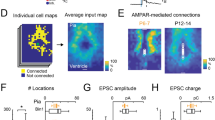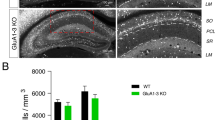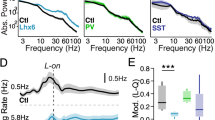Abstract
Many nonglutamatergic synaptic terminals in the mammalian brain contain the vesicular glutamate transporter 3 (VGLUT3), indicating that they co-release the excitatory neurotransmitter glutamate. However, the functional role of glutamate co-transmission at these synapses is poorly understood. In the auditory system, VGLUT3 expression and glutamate co-transmission are prominent in a developing GABA/glycinergic sound-localization pathway. We found that mice with a genetic deletion of Vglut3 (also known as Slc17a8) had disrupted glutamate co-transmission and severe impairment in the refinement of this inhibitory pathway. Specifically, loss of glutamate co-transmission disrupted synaptic silencing and the strengthening of GABA/glycinergic connections that normally occur with maturation. Functional mapping studies further revealed that these deficits markedly degraded the precision of tonotopy in this inhibitory auditory pathway. These results indicate that glutamate co-transmission is crucial for the synaptic reorganization and topographic specification of a developing inhibitory circuit.
This is a preview of subscription content, access via your institution
Access options
Subscribe to this journal
Receive 12 print issues and online access
$209.00 per year
only $17.42 per issue
Buy this article
- Purchase on Springer Link
- Instant access to full article PDF
Prices may be subject to local taxes which are calculated during checkout








Similar content being viewed by others
References
Tollin, D.J. The lateral superior olive: a functional role in sound source localization. Neuroscientist 9, 127–143 (2003).
Kim, G. & Kandler, K. Elimination and strengthening of glycinergic/GABAergic connections during tonotopic map formation. Nat. Neurosci. 6, 282–290 (2003).
Kotak, V.C., Korada, S., Schwartz, I.R. & Sanes, D.H. A developmental shift from GABAergic to glycinergic transmission in the central auditory system. J. Neurosci. 18, 4646–4655 (1998).
Nabekura, J. et al. Developmental switch from GABA to glycine release in single central synaptic terminals. Nat. Neurosci. 7, 17–23 (2004).
Gillespie, D.C., Kim, G. & Kandler, K. Inhibitory synapses in the developing auditory system are glutamatergic. Nat. Neurosci. 8, 332–338 (2005).
Allen, T.G., Abogadie, F.C. & Brown, D.A. Simultaneous release of glutamate and acetylcholine from single magnocellular “cholinergic” basal forebrain neurons. J. Neurosci. 26, 1588–1595 (2006).
Mentis, G.Z. et al. Noncholinergic excitatory actions of motoneurons in the neonatal mammalian spinal cord. Proc. Natl. Acad. Sci. USA 102, 7344–7349 (2005).
Nishimaru, H., Restrepo, C.E., Ryge, J., Yanagawa, Y. & Kiehn, O. Mammalian motor neurons co-release glutamate and acetylcholine at central synapses. Proc. Natl. Acad. Sci. USA 102, 5245–5249 (2005).
Boulland, J.L. et al. Expression of the vesicular glutamate transporters during development indicates the widespread co-release of multiple neurotransmitters. J. Comp. Neurol. 480, 264–280 (2004).
Somogyi, J. et al. GABAergic basket cells expressing cholecystokinin contain vesicular glutamate transporter type 3 (VGLUT3) in their synaptic terminals in hippocampus and isocortex of the rat. Eur. J. Neurosci. 19, 552–569 (2004).
Herzog, E. et al. Localization of VGLUT3, the vesicular glutamate transporter type 3, in the rat brain. Neuroscience 123, 983–1002 (2004).
Gras, C. et al. Developmentally regulated expression of VGLUT3 during early postnatal life. Neuropharmacology 49, 901–911 (2005).
Fremeau, R.T., Jr. et al. The identification of vesicular glutamate transporter 3 suggests novel modes of signaling by glutamate. Proc. Natl. Acad. Sci. USA 99, 14488–14493 (2002).
Gabellec, M.M., Panzanelli, P., Sassoe-Pognetto, M. & Lledo, P.M. Synapse-specific localization of vesicular glutamate transporters in the rat olfactory bulb. Eur. J. Neurosci. 25, 1373–1383 (2007).
Blaesse, P., Ehrhardt, S., Friauf, E. & Nothwang, H.G. Developmental pattern of three vesicular glutamate transporters in the rat superior olivary complex. Cell Tissue Res. 320, 33–50 (2005).
Seal, R.P. & Edwards, R.H. Functional implications of neurotransmitter co-release: glutamate and GABA share the load. Curr. Opin. Pharmacol. 6, 114–119 (2006).
Gras, C. et al. The vesicular glutamate transporter VGLUT3 synergizes striatal acetylcholine tone. Nat. Neurosci. 11, 292–300 (2008).
Seal, R.P. et al. Sensorineural deafness and seizures in mice lacking vesicular glutamate transporter 3. Neuron 57, 263–275 (2008).
Kandler, K. & Friauf, E. Development of glycinergic and glutamatergic synaptic transmission in the auditory brainstem of perinatal rats. J. Neurosci. 15, 6890–6904 (1995).
Kil, J., Kageyama, G.H., Semple, M.N. & Kitzes, L.M. Development of ventral cochlear nucleus projections to the superior olivary complex in gerbil. J. Comp. Neurol. 353, 317–340 (1995).
Stevens, C.F. & Wang, Y. Changes in reliability of synaptic function as a mechanism for plasticity. Nature 371, 704–707 (1994).
Goda, Y. & Stevens, C.F. Two components of transmitter release at a central synapse. Proc. Natl. Acad. Sci. USA 91, 12942–12946 (1994).
Kandler, K., Katz, L.C. & Kauer, J.A. Focal photolysis of caged glutamate reveals an entirely postsynaptic form of hippocampal long-term depression. Nat. Neurosci. 1, 119–123 (1998).
Sommer, I., Lingenhöhl, K. & Friauf, E. Principal cells of the rat medial nucleus of the trapezoid body: an intracellular in vivo study of their physiology and morphology. Exp. Brain Res. 95, 223–239 (1993).
Leao, R.N., Berntson, A., Forsythe, I.D. & Walmsley, B. Reduced low-voltage activated K+ conductances and enhanced central excitability in a congenitally deaf (dn/dn) mouse. J. Physiol. (Lond.) 559, 25–33 (2004).
Walmsley, B., Berntson, A., Leao, R.N. & Fyffe, R.E. Activity-dependent regulation of synaptic strength and neuronal excitability in central auditory pathways. J. Physiol. (Lond.) 572, 313–321 (2006).
Turrigiano, G.G. The self-tuning neuron: synaptic scaling of excitatory synapses. Cell 135, 422–435 (2008).
Wu, S.H. & Kelly, J.B. Physiological properties of neurons in the mouse superior olive: membrane characteristics and postsynaptic responses studied in vitro. J. Neurophysiol. 65, 230–246 (1991).
Forsythe, I.D. & Barnes-Davies, M. The binaural auditory pathway - membrane currents limiting multiple action potential generation in the rat medial nucleus of the trapezoid body. Proc. Biol. Sci. 251, 143–150 (1993).
Sanes, D.H. & Rubel, E.W. The ontogeny of inhibition and excitation in the gerbil lateral superior olive. J. Neurosci. 8, 682–700 (1988).
Tritsch, N.X., Yi, E., Gale, J.E., Glowatzki, E. & Bergles, D.E. The origin of spontaneous activity in the developing auditory system. Nature 450, 50–55 (2007).
Lippe, W.R. Rhythmic spontaneous activity in the developing avian auditory system. J. Neurosci. 14, 1486–1495 (1994).
Ramakrishnan, N.A., Drescher, M.J. & Drescher, D.G. Direct interaction of otoferlin with syntaxin 1A, SNAP-25, and the L-type voltage-gated calcium channel Cav1.3. J. Biol. Chem. 284, 1364–1372 (2009).
Roux, I. et al. Otoferlin, defective in a human deafness form, is essential for exocytosis at the auditory ribbon synapse. Cell 127, 277–289 (2006).
Longo-Guess, C., Gagnon, L.H., Bergstrom, D.E. & Johnson, K.R. A missense mutation in the conserved C2B domain of otoferlin causes deafness in a new mouse model of DFNB9. Hear. Res. 234, 21–28 (2007).
Beurg, M. et al. Calcium- and otoferlin-dependent exocytosis by immature outer hair cells. J. Neurosci. 28, 1798–1803 (2008).
Schwander, M. et al. A forward genetics screen in mice identifies recessive deafness traits and reveals that pejvakin is essential for outer hair cell function. J. Neurosci. 27, 2163–2175 (2007).
Sanes, D.H. An in vitro analysis of sound localization mechanisms in the gerbil lateral superior olive. J. Neurosci. 10, 3494–3506 (1990).
Kandler, K. & Friauf, E. Pre- and postnatal development of efferent connections of the cochlear nucleus in the rat. J. Comp. Neurol. 328, 161–184 (1993).
Ruel, J. et al. Impairment of SLC17A8 encoding vesicular glutamate transporter-3, VGLUT3, underlies nonsyndromic deafness DFNA25 and inner hair cell dysfunction in null mice. Am. J. Hum. Genet. 83, 278–292 (2008).
Jones, T.A., Leake, P.A., Snyder, R.L., Stakhovskaya, O. & Bonham, B. Spontaneous discharge patterns in cochlear spiral ganglion cells before the onset of hearing in cats. J. Neurophysiol. 98, 1898–1908 (2007).
Leake, P.A., Hradek, G.T., Chair, L. & Snyder, R.L. Neonatal deafness results in degraded topographic specificity of auditory nerve projections to the cochlear nucleus in cats. J. Comp. Neurol. 497, 13–31 (2006).
Leao, R.N. et al. Topographic organization in the auditory brainstem of juvenile mice is disrupted in congenital deafness. J. Physiol. (Lond.) 571, 563–578 (2006).
Gaiarsa, J.L., Caillard, O. & Ben Ari, Y. Long-term plasticity at GABAergic and glycinergic synapses: mechanisms and functional significance. Trends Neurosci. 25, 564–570 (2002).
Morishita, W. & Sastry, B.R. Postsynaptic mechanisms underlying long-term depression of GABAergic transmission in neurons of the deep cerebellar nuclei. J. Neurophysiol. 76, 59–68 (1996).
Aamodt, S.M., Shi, J., Colonnese, M.T., Veras, W. & Constantine-Paton, M. Chronic NMDA exposure accelerates development of GABAergic inhibition in the superior colliculus. J. Neurophysiol. 83, 1580–1591 (2000).
McLean, H.A., Caillard, O., Ben-Ari, Y. & Gaiarsa, J.L. Bidirectional plasticity expressed by GABAergic synapses in the neonatal rat hippocampus. J. Physiol. (Lond.) 496, 471–477 (1996).
Akerman, C.J. & Cline, H.T. Depolarizing GABAergic conductances regulate the balance of excitation to inhibition in the developing retinotectal circuit in vivo. J. Neurosci. 26, 5117–5130 (2006).
Behrends, J.C. & ten Bruggencate, G. Changes in quantal size distributions upon experimental variations in the probability of release at striatal inhibitory synapses. J. Neurophysiol. 79, 2999–3011 (1998).
Acknowledgements
We thank D. Gillespie for initial recordings from Vglut3−/– mice and K. Cihil for help with genotyping. Otoferlin knockout mice (pachanga)37 were generously supplied by U. Mueller (Scripps Institute). We are grateful to E. Aizenman, J. Castro, A. Clause and T. Tzounopoulos for comments on the manuscript. K.K. was supported by the National Institute on Deafness and Other Communication Disorders (DC-04199), R.P.S. by the National Alliance for Research on Schizophrenia and Depression and R.H.E. by the National Institute on Drug Abuse and the National Institute of Mental Health.
Author information
Authors and Affiliations
Contributions
J.N. conducted electrophysiological experiments and data analysis, R.P.S. and R.H.E. created the Vglut3−/− mice and participated in the study design, J.A.G. conducted genotyping and participated in data analysis, J.N. and K.K. designed the experiments and J.N., R.P.S., R.H.E. and K.K. wrote the paper.
Corresponding author
Supplementary information
Supplementary Text and Figures
Supplementary Figures 1–3 (PDF 1989 kb)
Rights and permissions
About this article
Cite this article
Noh, J., Seal, R., Garver, J. et al. Glutamate co-release at GABA/glycinergic synapses is crucial for the refinement of an inhibitory map. Nat Neurosci 13, 232–238 (2010). https://doi.org/10.1038/nn.2478
Received:
Accepted:
Published:
Issue Date:
DOI: https://doi.org/10.1038/nn.2478
This article is cited by
-
Glutamate and GABAA receptor crosstalk mediates homeostatic regulation of neuronal excitation in the mammalian brain
Signal Transduction and Targeted Therapy (2022)
-
Long-term microglia depletion impairs synapse elimination and auditory brainstem function
Scientific Reports (2022)
-
GABAB receptors constrain glutamate presynaptic release and postsynaptic actions in substantia gelatinosa of rat spinal cord
Brain Structure and Function (2022)
-
Long-term potentiation of glycinergic synapses by semi-natural stimulation patterns during tonotopic map refinement
Scientific Reports (2020)
-
The role of co-neurotransmitters in sleep and wake regulation
Molecular Psychiatry (2019)



